Tag: pine
Pints & Pinecones in Eugene

The Eugene Branch showed off their epic cone collection at Oakshire Brewing
This month, the Eugene Branch put on a tree trivia—Treevia!—at Oakshire Brewing. The Eugene staff was joined by partners, arborists, volunteers, and supporters to talk trees over a few pints, and a dollar from each beer went back to Friends of Trees. “It was a fitting place because the brewery is in the Whiteaker neighborhood in Eugene, which is famous for tree advocacy,” says Eugene Director Erik Burke.
For the trivia, they focused on cones, the strange and varied structures that are specific to conifer trees. On a table at Oakshire Brewing, FOT laid out an assortment of cones, big and small, prickly and smooth, and asked folks to match them to their corresponding trees.
“We had a great turn out of familiar faces,” says Taylor Glass, the volunteer and program specialist in Eugene. “Showing them all these really cool cones, it’s a fun way to connect.”

It’s not just pine trees that make cones. Cypresses and cedars also produce cones in order to reproduce. Pines, cypresses, and cedars are all conifers—so named for their cones, of course. “Male cones that put out pollen, which has already started,” says Erik. “What we think of as pine cones are the female seed cones.”
The little plates in the cones, called bracts, each contain an individual seed. Some deciduous trees, like our native white alder, also produce male pollen structures called catkins and the female catkins turn into cones that look like pine cones.
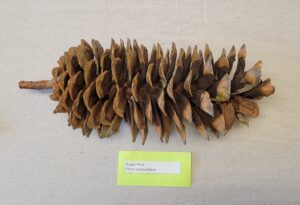
Sugar Pine: Native people ate valley ponderosa pine and sugar pine seeds. In fact, most of the seeds in cones in the pine family are edible (pine nuts)!
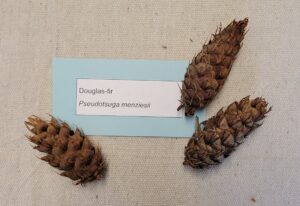
The Douglas-fir is the most common tree in the Pacific Northwest and it’s cone is very recognizable. The story is that a mouse was running along, and a hawk swooped down on it, so it jumped inside the cone, but you can still see its little feet sticking out.
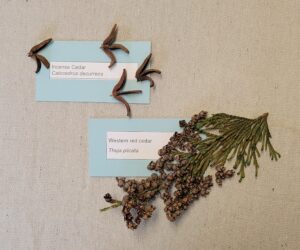
The Oregon native trees that we call natives, incense cedar and western red cedar, are actually in the cypress family. Incense cedars have little cones that look like duck bills, and western red cedar cones look like little roses.
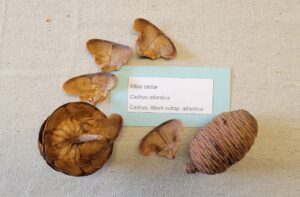
True cedars are in the pine family and come from Africa, Asia and Europe. Not everything we call a cedar is a true cedar. You can tell the cones of true cedars, like the Atlas cedar, because they stick up vertically and shed their bracts one by one while staying attached to the tree.
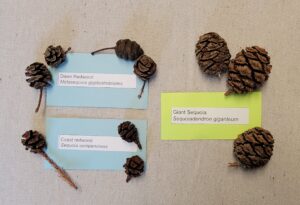
How amazing that redwoods and sequoias, the largest trees in North America, come from these little cones and have tiny seeds.
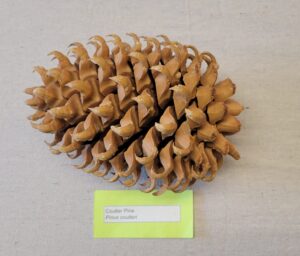
The Coulter pine’s cone is pretty intense! It’s got sharp points, and it’s heavy too, so heads up!
World’s tallest pine discovered in Oregon

Oregon is home to the world’s tallest pine tree, according to a story in today’s Mail Tribune. The following is an excerpt from the story about two men who discovered the tallest pine (268.35 feet) in the Rogue River-Siskiyou National Forest:
Unless you are an eagle soaring above the conifer forest or a big-tree hunter with an eagle eye, chances are you wouldn’t give the ponderosa pine a second glance. After all, it is but one of many wooden spires reaching into the green forest canopy high overhead in the Rogue River-Siskiyou National Forest.
But mammoth-tree hunters Michael Taylor of Trinity County, Calif., and Mario Vaden of Beaverton instantly knew on Jan. 3 they had discovered a new pine king.
“We were walking along, saw the top of the tree sticking up, and we both said, ‘Wow!'” Taylor said. “I knew right away it was the tallest.”
“We have a new world record,” Vaden said.
Not only is the ponderosa, at 268.35 feet high, the tallest known of its species, it is also the tallest known pine tree of any pine species on the planet, they say.
Consider this: The pine’s height is roughly 32 feet shy of a football field turned on end.
Ponderosa Pine was Friends of Trees’ “staff pick” for October. Read why Neighborhood Trees Specialist Kate Farrington chose it as her favorite tree. We still have some available (and many other species, too) for homeowners to buy this year. Just be sure your tree has plenty of room to grow!
–TR
Oak-tober staff picks
By Chelsea Schuyler
Ever wonder what Friends of Trees staff members think about all day? Well TREES, of course. But which ones?

Today’s pick: the Ponderosa Pine.
Which tree does Kate Farrington, Neighborhood Trees Specialist, favor and why?
“Oh, the native Ponderosa Pine! I have loved this tree since I was a child, because the smell of pine has always reminded me of summer. My family spent our summers in northern Idaho on Coeur d’Alene Lake where the dry climate is ideal for pine trees. The pungent pine smell always welcomed me home there.”
These fast-growing, majestic trees can reach 200 feet in height and live as long as 100 years. Their needles can grow up to 10 inches long, and they have distinctive orange, deeply-grooved bark. The seeds are food for various kinds of birds, chipmunks, and squirrels, making the Ponderosa Pine an excellent wildlife tree.
Here’s a trick to help you identify a Ponderosa Pine. If you stand next to the trunk and notice that the bark smells like Butterscotch, you’ve got yourself a Ponderosa Pine—because one must “ponder” why it smells of that nostalgic hard candy deliciousness we all grew up with.
So what’s your favorite tree? What will your children associate with their childhood play?
You can create memories for future generations by buying a tree from Friends of Trees at up to 70 percent less than you’d pay a contractor, and the payoff will be years running. Because of their height, we only sell Ponderosa Pines for yards, not planting strips, but we have many other options for planting strips.
You wouldn’t believe how much a tree can benefit property value and stormwater runoff. Check out the Tree Calculator to see for yourself how a Ponderosa Pine or your favorite tree could benefit your home, neighborhood, and the environment.
Happy planting!
The oldest trees in the world
Older than the Pyramids, as old as Stonehenge, and ‘around the time the Polynesians settled Fiji’—these are the types of expressions used to describe the age of the world’s oldest trees.
This collection of photos and descriptions, published last week by Wired, displays some of the most ancient trees on the planet.
Scroll to the bottom to see an almost 10,000-year-old tree in Sweden that’s about the same size as Friends of Trees plants via its Neighborhood Trees program!

From Wired.com:
The world’s oldest individual tree lives 10,000 feet above sea level in the Inyo National Forest, Calif. A staggering 4,765 years old, this primeval tree was already a century old when the first pyramid was built in Egypt. The tree is hidden among other millennia-old Great Basin bristlecone pines in a grove called the Forest of Ancients. To protect the tree from vandalism, the forest service keeps its exact location secret, but this one looks like it could be Methuselah.

From Wired.com:
This cryptomeria tree’s 83-foot height and 53-foot girth makes it the largest conifer in Japan. The tree grows in a misty, old-growth forest on the north face of the tallest mountain on Yakushima island in Japan. Tree rings indicate the venerable cryptomeria is at least 2,000 years old, though some estimate it could be as old as 7,000 years.

From Wired.com:
This giant cypress lives in Abarkooh, Iran. The evergreen took root between 4,000 and 4,500 years ago, around the time that Stonehenge was being completed. It may be the oldest living thing in Asia, and is a national monument in Iran. The Zorastrian Sarv stands about 82 feet high and has a girth of 37.8 feet.
The seven wonders of the tree world
Courtesy of the Mother Nature Network, this slideshow series identifies the most important, significant, amazing … trees in the world.

Description from mnn.com:
This redwood tree is located in Sequoia National Park in California and is believed to be between 2,300 and 2,700 years old. It towers about 275 feet above the ground, is the largest non-clonal tree in the world by volume, and is more than 100 feet around at the base.

Description from mnn.com:
The Tule Tree, or El Árbol del Tule, is a Montezuma cypress tree on the grounds of a church in Santa María del Tule, in the Mexican state of Oaxaca. It measures more than 119 feet around but is only 116 feet high. It’s believed that the tree is about 2,000 years old.
